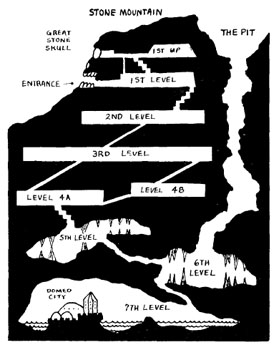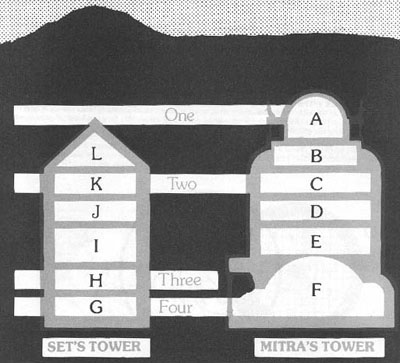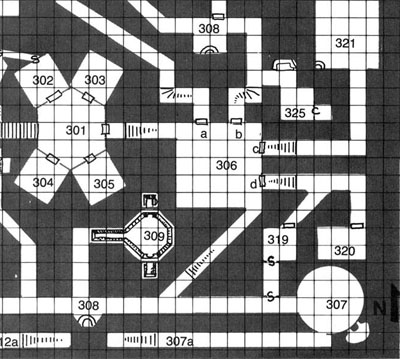Let’s start by taking a look at some of the basic techniques you can use while creating non-linear dungeons.
Some of these techniques are designed to offer complex geographic relationships (out of which meaningful choices can naturally arise). Others are designed to confuse the mapping of the complex (or, even in a game dynamic without player mapping, to confound their general understanding of the complex). The point is not (necessarily) to create a maze-like environment, but rather to create an environment of sufficient complexity that the “hand of the author” and the underlying structure of the dungeon environment become obfuscated.
MULTIPLE ENTRANCES: Multiple entrances give the PCs an immediate strategic choice as they approach the dungeon complex. Hidden secondary entrances also reward exploration both inside and outside of the dungeon, allowing for favorable approaches and quick escapes. In terms of structure, multiple entrances effectively create an additional “loop” (see below) through the surface above the dungeon.
For example, consider the classic Stone Mountain dungeon from the 1977 D&D Basic Set, designed by Tom Moldvay and Tom Wham:
LOOPS: Branching paths in a dungeon allow for choice, but are still functionally linear in their design. (In practice, you will follow a branch to its end; backtrack; and then go down a different branch. But each branch still presents a linear experience.) Where things get interesting is when you grab a couple of those branches and hook them together into a loop. These loops are the basic building blocks for non-linear dungeons: They provide meaningful strategic and tactical choices; make exploration meaningful; and allow PCs to find alternative routes around or through potential threats.
MULTIPLE LEVEL CONNECTIONS: If there is only a single route leading to the next level of the dungeon the complexity of the current level is collapsed into a chokepoint. But if you introduce multiple connections between the dungeon levels you create a synergy between complex level designs. Just as you create new structural loops by including multiple entrances to the dungeon, each additional connection you draw between levels creates new looping paths through the dungeon.
DISCONTINUOUS LEVEL CONNECTIONS: In a linear design, the levels of a dungeon must proceed in their predetermined order: Level 1 leads to Level 2. Level 2 leads to Level 3. And Level 3 leads to Level 4.
But once you introduce multiple connections between levels, you are free to have some of those connections skip levels. For example, there might be an elevator on Level 1 that takes you down to Level 3. Or a hidden tunnel on Level 4 that takes you back to the surface a half mile away from the dungeon’s main entrance.
SECRET & UNUSUAL PATHS: These are fairly self-explanatory. They reward curiosity and exploration, and can also breathe fresh life into areas of the dungeon which have already been traversed.
One thing to note is that not every secret path needs to take the conventional form of a camouflaged doorway: Tunnels that have suffered cave-ins. Traps that drop you to lower levels. Archaic teleportation systems that must be decoded. Rope bridges that cross over caverns that can also be explored from below. A submerged bypass connecting two seemingly unrelated lakes.
And here, too, you benefit from the non-linear design of the xandered dungeon: Because there are other viable paths for the PCs to explore, you can include truly esoteric, unusual, and flavorful paths that may be missed by the unwary (and, therefore, appreciated all the more by those who do discover them).
SUB-LEVELS: The distinction between a “level” and a “sub-level” is somewhat arbitrary, but perhaps the defining characteristic of the sub-level is that it departs from the main “sequence” of the dungeon. It may be smaller than the other levels of the dungeon; it may be difficult to reach; or both. As such, sub-levels serve as boulevards of discovery or elaborate shortcuts (or both).
DIVIDED LEVELS: Similar to the concept of a sub-level is that of the divided level. While existing within the main “sequence” of the dungeon, a divided level cannot be completely traversed without going through the levels above or below it.
For example, on the second level of the dungeon one might find two staircases both leading down to the third level. But on the third level itself, there is no path which connects the two staircases. (Or, if there is such a path, it may be incredibly well hidden or difficult to traverse.)
NESTED DUNGEONS: Nested dungeons are sort of like sub-levels or divided levels on steroids. Imagine designing two separate and distinct dungeon complexes, but then linking them together at selected locations. (For example, consider the Lost Temple of the Gorgons and the Obsidian Caverns as both being fully developed dungeon complexes, each with multiple levels and sub-levels. You could nest the Lost Temple within the Obsidian Caverns by creating two links between the complexes: A long passage on the first level of the former might lead to the third level of the latter. And a teleportation pad on the sixth level of the latter might lead to the fifth level of the former.)
As a practical demonstration of this technique, consider Jaquays’ Dark Tower:
Both Set’s Tower and Mitra’s Tower are nested into the four primary levels of the dungeon.
MINOR ELEVATION SHIFTS: When the PCs come to a staircase they may naturally assume that they are going up or down to a new level of the dungeon. But by including minor elevation shifts within the topography of a single dungeon level you can confound their expectations. Here’s an example from the Temple of Elemental Evil by Gary Gygax and Frank Mentzer:
In addition to short stairways and misleading slopes, you can also include tunnels that loop under each other while technically remaining on the same “level” of the dungeon. It’s also important to “think vertically” within rooms as well.
These techniques aren’t just a matter of confusing the players’ mapping. You are disrupting their ability to intuit the organization of your maps by analyzing the reality of the game world. While maintaining clean and simple maps for your own use and reference, you are creating a world that not only seems more dynamic and complex, but actually is more dynamic and complex.
Basically, don’t fall into the trap of thinking that just because your map is two-dimensional that the world should be two-dimensional.
MIDPOINT ENTRY: I don’t think Jaquays ever used this technique, but you can complicate the players’ approach to the dungeon by creating immediate bilateral exploration. In other words, PCs entering a dungeon are usually only faced with one navigational question at the macro-level: “How do we get down to level 2?”
But if the PCs are instead entering in the middle of the dungeon – with levels above and below them – then they’re first faced with a tougher question: “Which way do we go?”
Note that this decision point is similar to the one faced by PCs who have “skipped” a level as a result of a discontinuous level connection. It is also similar to the situation faced by PCs who have taken advantage of a hidden entrance leading to a lower level of the dungeon. The distinction of the midpoint entry is that it is the expected, default entry point to the dungeon. (And in classic dungeon arrangements, where difficulty corresponds to dungeon level, the difficulty of the dungeon would increase in both directions away from the midpoint entry.)
NON-EUCLIDEAN GEOMETRY: If you want to have some real fun, consider using non-Euclidean geometry. These Escher-inspired designs can result in counter-intuitive navigation and may even result in PCs moving between levels without realizing that it’s happened. For examples of non-Euclidean design, check out my work on FFG’s The Lost Hunt and the award-winning Halls of the Mad Mage.
EXTRADIMENSIONAL SPACES: Sections of a dungeon complex may lead into areas completely beyond the dungeon itself while still remaining intimately tied to the dungeon’s topography and/or experience. For example, Gary Gygax’s EX1 Dungeonland module detailed a Wonderland-inspired demi-plane that could be accessed deep below Castle Greyhawk. I’ve read about another DM incorporating the lost island of X1 The Isle of Dread as a similar demi-plane within their megadungeon complex.
While such excursions can certainly breathe a little air into a claustrophobic dungeon delve, I think it remains an open question where the distinction between an extradimensional space which “belongs” to the dungeon and a teleportation effect which simply takes the PCs out of the dungeon entirely actually lies. In practice, the line between the two is probably more a blur than a distinct demarcation.
Laying aside these broader questions, I include extradimensional spaces in the list of xandering techniques because they also allow you to super-impose multiple areas into a single geographic space.















ARCHIVED HALOSCAN COMMENTS
Guest
I have Castle Whiterock, but I don’t play 3e. From an old-school D&D perspective, one of the problems with Castle Whiterock is that the levels are too small – they don’t contain enough experience points to allow the PCs to level up. One solution I have considered would be to reduce the toughness of all the levels below the 3rd or 4th, so that the 20th level ends up being suitable for, say, 12th level characters. But another option I have thought about would be to put Castle Whiterock next to Monte Cook’s Dragons Delve dungeon and nest the two dungeons together by connecting some of the levels. I would really like to do this one day, time and money permitting.
I also feel there are several rather linear 3e adventures that could be improved by just amalgamating them with another such adventure, and creating a new map for the resulting dungeon, one which would have a few more interesting features and a few more “empty” rooms.
Thursday, July 29, 2010, 5:45:10 PM
Noumenon
Someone at Goodman Games has seen that Holmes Basic Set map. The side view of Castle Whiterock is drawn almost exactly the same.
Tuesday, July 27, 2010, 3:34:01 AM
Inspirational! I loved these dungeons back in their day. Thank you for spelling out what makes them work so well. The examples and guidance on applying the same design principles in new dungeons have me rethinking several dungeons…
thank you sir, thank you.
“For example, module EX1 Dungeonland detailed a Wonderland-inspired demi-plane that could be accessed deep below Castle Greyhawk. I’ve read about another DM incorporating the lost island of X1 The Isle of Dread as a similar demi-plane within their megadungeon complex.”
It’s possible that you’re thinking of the _same_ DM: “Thus, in my ‘Greyhawk Campaign’ I included an ‘Alice In Wonderland’ level… similarly, there are places where adventurers can journey to a land of pure Greek mythology, into the future where the island of King Kong awaits…” etc. (Gygax in DMG p. 112) That is: Module WG6.
[…] You might notice that both levels contain several “loops” (Level 1 has 11 and there are 9 on Level 2, although some are only accessible via secret doors). To my mind these are essential and I get grumpy when I encounter dungeons without plenty of loopage. Why? I can do no better than quote Justin Alexander’s words from his excellent series on [Xandering] the Dungeon: […]
[…] С оригиналом Вы можете ознакомиться здесь […]
[…] is simple but for a one-shot there is nothing wrong with that. The included dungeon map uses some circular routes which is a plus for such a small dungeon. There are some interesting features, traps etc. I really […]
I’ve watched a lot of how to tutorials on dungeon and adventure (these concepts could be applied just as easily to plot) design, and I’ve seen some cool little ideas here and there. But this…this is the real deal. What I was looking for. As said above, you spell out very well what it is that made me love certain dungeons (or plots) in certain games. On paper or in video game form. You’re giving excellent methods of confounding the usual 2-d feel of a map. You mentioned making the players have to analyze the description of their environment. I think this is an aspect of game/level design that’s often HIGHLY underrated. We’re supposed to try to put the players IN these environments. We’ve all done left or right, north or south, can’t open the locked door without the key. We can do that on autopilot with little attention or excitement. We can write flavor text, and that helps, but it’s even better to get the players actively asking for a description. Giving them choices in which path they take while not making it obvious if they are choosing “right” or “wrong” makes them look more closely at their surrounding to find the details that hint at what their choices have brought them to. This can be rewarded by letting them use what they’ve noticed to their advantage.
I think this goes beyond tips or tricks or good design. It’s an aesthetic that can apply to many things involving the imagination.
Unrelated: this inspires me in a way that reminds me of how I felt when I looked at the mapped out possible paths through the game for the Sega Genesis called “Kid Chameleon.” Also, old choose your adventure books.
(Forgot this) Kid Chameleon level map:
http://kidchameleon.wikia.com/wiki/Map
Many levels had multiple entrances and exits. A great example of nesting levels for a HUGE amount of replayabilty on an otherwise typical platformer.
Sorry to double post
[…] Souls level design is almost a stereotypical example of a well-[xandered] dungeon. Multiple entrances, loops (shortcuts!), discontinuity, secret paths, sub levels (upper and lower […]
[…] other design frameworks I’ve considered during this project are the [Xandering] Technique advocated by Justin Alexander, and the Five Room […]
Midpoint access in Caverns of Thracia could be achieved by having the players enter through the hole (F on the outside map) just to the north of the cultist’s entrance. It drops you where the cultists may be having a ritual, but if the players drop in here and there is no ritual, they can also drop further to the abyss and down to the 2nd level.
Sidebar: when building a dungeon avoid the “Left is always best!” cliche’…